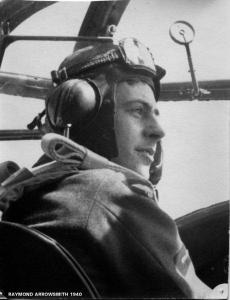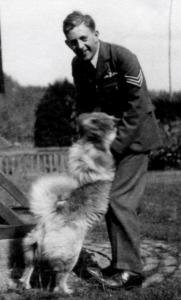
|

|
| Flight Sergeant John Raymond St George ARROWSMITH (931603) | |
|
103 Squadron Royal Air Force Date of birth: 23rd April 1918 Date of death: 5th May 1942 Killed in action aged 24 Commemorated on the Runnymede Memorial Panel 73 |

|
| John Raymond St George Arrowsmith was born at Reading in Berkshire on the 23rd of April 1918 the elder son of Henry Arrowsmith and Margaret Joan (nee Pearson) Arrowsmith of 4, Kensington Court Gardens, South Kensington in London. He was educated at Lancing College where he was in Seconds House from January 1932 to July 1936. He went on to Wye Agricultural College from 1936 to 1940 and achieved a BSc (Lond) in 1940. While at college he worked on his uncle's farm and lived at "Little Whitmans", Tenderden in Kent. On leaving college he joined the Royal Air Force Volunteer Reserve and was sent to Canada for pilot training. Although he was offered a commission he refused, preferring to remain a Sergeant. On completing his training he was posted to 103 Squadron in early March 1942, operating Wellington bombers. He flew on his first operation, to Essen, on the night of the 25th/26th of March 1942. By May 1942, he had been promoted to Flight Sergeant and, in terms of numbers of operations flown, he was one of the most experienced pilots in the squadron. On the morning of the 4th of May 1942 Raymond Arrowsmith and his crew were detailed for an operation on St Nazaire, but were unable to take off due to an unserviceable intercom. They were instead sent on a mission that night. On the night of the 4th/5th of May 1942 Bomber Command's despatched 121 aircraft for an operation on Stuttgart. In minor operations that night they sent nine aircraft to Nantes, five aircraft to Pilsen, eight aircraft on minelaying operations off Heligoland and six aircraft on a leaflet dropping operation over France. Raymond Arrowsmith and his crew took off from RAF Elsham Wolds at 12.08am on morning of the 5th of May 1942 in Wellington Mark 1C Z8833 PM-L for the operation to Nantes, where a number of small tankers were reported to be in the harbour. They were detailed to bomb the inland docks and to drop leaflets. It would be his sixteenth operation and his first as the Captain of the aircraft on an operation. Weather conditions were good en route but the target area was covered by a thick ground haze and, although the crews all dropped their bombs, they were unable to report the results. Although they had reached and bombed the target, by the time the aircraft returned over the enemy coast it was heavily damaged and Raymond Arrowsmith alerted the crew that he was going to attempt to force land the stricken aircraft on the sea. He ordered the front gunner to the back of the aircraft to assist the rear gunner. As the aircraft was some fifty feet above the surface of the sea, about twenty miles off Cherbourg, it broke in two, killing all those in the front half which sank immediately. The two gunners in the rear of the aircraft managed to escape from the tail section and climb into the life raft. The rest of the crew was lost. The crew was: - Flight Sergeant John Raymond St George Arrowsmith (Pilot) Sergeant Walter Gordon Harrison (2nd Pilot) Flight Sergeant George Arthur McLean RCAF (Observer) Sergeant Philip Robert Abbas (1st Wireless Operator/Air Gunner) Flight Sergeant George William Gibb RCAF (2nd Wireless Operator/Front Gunner) POW (No. 410 Stalag Luft III and Stalag Luft VI) Sergeant Kenneth Frank Adlam (Rear Gunner) POW (Stalag Luft III, Stalag Luft VI and Stalag 357) Theirs was the only aircraft lost on the Nantes raid. On the 11th of May the aircrafts dingy came ashore on the west coast of France. The two men separated with Kenneth Adlam, who was suffering from a head injury, surrendering to two Germans on the beach. George Gibb, who had slept for much of his time in the raft, made his way inland where he sheltered in the home of a local doctor before being captured two days later. Kenneth Adlam wrote a letter to his family from hospital in Paris dated the 31st of May 1942: - "I'm sorry to have to tell you that Phil Abbas is dead. He was in the nose of the plane when it hit the water. Gibb and myself are the only ones who could have got out as the tail broke off and fell away. The front went down right away. Perhaps you could break this to his wife eh? I suppose he is posted missing along with the rest of the crew. I was swimming and saw it go down and not a sound did I hear. I guess the impact killed them all. Perhaps it would be better if she knew. I'll leave that to you." He gave the following statement in July 1942, while in prisoner of war camp: - "Returning from operations of May 5th, our aircraft crashed into the sea in mid Channel and broke up. The front and rear gunners were the only members of the crew able to get clear of the wreckage and make use of the dingy. I distinctly remember the wireless operator still transmitting an S.O.S. at the time we hit the water. Nothing more was heard of the remainder of the crew, and we were a long way from land and the aircraft sinking rapidly, I can only conclude that the remainder of the crew were either killed by the impact, or trapped and drowned." He is commemorated on the war memorial at Wye Agricultural College. |
|
 | |
| Seconds House |
Back